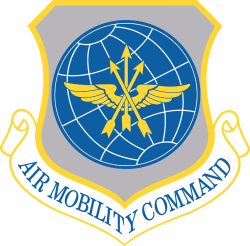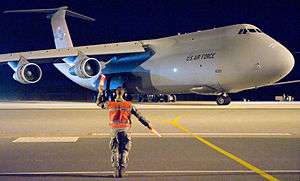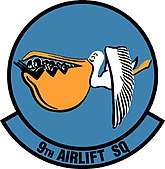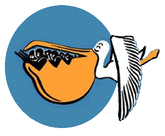9th Airlift Squadron
The 9th Airlift Squadron is a unit of the United States Air Force, part of the 436th Airlift Wing Air Mobility Command based at Dover Air Force Base, Delaware. It operates C-5M Galaxy aircraft supporting the United States Air Force global reach mission worldwide. The mission is to provide services and support which promote quality of life and project global power through combat-proven airlift and airdrop.
9th Airlift Squadron
 | |
|---|---|
 A 9th Airlift Squadron C-5B is marshalled out of its parking spot for a mission 8 March 2012[note 1] | |
| Active | 1940–1946; 1949–1951; 1953–1963; 1965–1968; 1971–present |
| Country | |
| Branch | |
| Role | Airlift |
| Part of | Air Mobility Command |
| Garrison/HQ | Dover Air Force Base, Delaware |
| Nickname(s) | Proud Pelicans |
| Engagements | American Theater of Operations Pacific Theater of Operations[1] |
| Decorations | Air Force Outstanding Unit Award Republic of Vietnam Gallantry Cross with Palm[1] |
| Insignia | |
| 9th Airlift Squadron emblem[note 2] |  |
| 9th Troop Carrier Squadron emblem (approved 10 February 1943)[1] |  |
Mission
The 9th Airlift Squadron provides worldwide airlift to meet Department of Defense, Department of State and Presidential mobility requirements.
History
World War II
Constituted 9th Transport Squadron on 1 January 1938. Activated on 1 December 1940 at Patterson Field, OH with C-34. Moved to Brookley Field, AL, 18 September 1941, then to Camp Williams, WI, 24 May 1942. Redesignated 9th Troop Carrier Squadron on 4 July 1942. Relocated to Dodd Field, TX, c. 18 Sep 1942; Stuttgart, AR, 11 Nov 1942; Victorville, CA, 18 December 1942; Ft Sumner AAFld, NM, 4 Mar 1943; Lawson Field, GA, 7 May 1943; Grenada AAFld, MS, c. 3 Jun 1943-17 Jan 1944; Hickam Field, TH, 21 Feb 1944; Abemama Island, 27 Mar 1944; Saipan, 4 Aug 1944; Guam, Jul-15 Oct 1946.[1]
The squadron provided aerial transportation in Central, Western, and Southwestern Pacific, during World War II. Inactivated on 15 October 1946.[1]
Redesignated 9th Troop Carrier Squadron, Medium, on 10 May 1949. Activated in the Reserve on 27 Jun 1949 at Floyd Bennett NAS, NY, 27 June 1949-9 May 1951. Moved to Altus AFB, OK, 20 June 1953, with C-124. The 9th conducted replacement training through 1943, and subsequently aerial transportation in the Pacific Theater during World War II.[1]
Strategic airlift
It has provided worldwide airlift since 1953. The 9th resupplied scientific camps in Antarctica from 1959–1961, and 1965–1968. Relocated to Dover AFB, DE, 1 January 1965. Redesignated 9th Military Airlift Squadron on 8 January 1966. It also flew missions to Southeast Asia from 1965–1968 with C-141 Starlifters, discontinued, and inactivated, on 8 September 1968. Activated on 1 April 1971, with C-5 Galaxys. Participated in the evacuation of refugees from Southeast Asia in April 1975. The squadron supported operations in Grenada, 24 October 1983 – 11 December 1983; Panama, 19 December 1989 – 14 January 1990; and Southwest Asia, August 1990–July 1991.[1] Redesignated 9th Airlift Squadron on 1 December 1991.[1]
The last C-5B left the squadron on March 12, 2012. The 9th Airlift Squadron is now a C-5M Super Galaxy exclusive unit.[2]
Lineage
- Constituted as the 9th Transport Squadron on 1 January 1938
- Activated on 1 December 1940
- Redesignated 9th Troop Carrier Squadron on 4 July 1942
- Inactivated on 15 October 1946
- Redesignated 9th Troop Carrier Squadron, Medium on 10 May 1949
- Activated in the reserve on 27 June 1949
- Ordered to active service on 1 May 1951
- Inactivated on 9 May 1951
- Redesignated 9th Troop Carrier Squadron, Heavy on 19 March 1953
- Activated on 20 June 1953
- Discontinued and inactivated on 18 January 1963
- Activated on 13 November 1964 (not organized)
- Organized on 1 January 1965
- Redesignated 9th Military Airlift Squadron on 8 January 1966
- Discontinued and inactivated on 8 September 1968
- Activated on 1 April 1971
- Redesignated 9th Airlift Squadron on 1 December 1991[1]
Assignments
|
|
Stations
|
|
Aircraft
- Douglas C-33 (1940–1941)
- Douglas C-34 (1940–1941)
- Douglas C-39 (1940–1941)
- Douglas C-47 Skytrain (1942–1946, 1949–1951)
- Douglas C-50 (1942)
- Douglas C-53 Skytrooper (1942–1943)
- Curtiss C-46 Commando (1945–1946)
- Douglas C-54 Skymaster (1946)
- Douglas C-124 Globemaster II (1953–1963, 1965-1966)
- Lockheed C-141 Starlifter (1966–1968)
- Lockheed C-5A Galaxy (1971–unknown)
- Lockheed C-5B Galaxy (unknown–2012)
- Lockheed C-5M Super Galaxy (2009–present)[1]
Operations
References
Notes
- Explanatory notes
- Aircraft is Lockheed C-5B, serial 86-20. This was the last active-duty C-5B mission flown at Dover AFB.
- The emblem was modified between 1963 and 1995 to bring all elements within the disc and comply with Air Force regulations. Compare image and desctiption in Maurer, Combat Squadrons, p.54 with those in Endicott, pp. 402-403.
- Citations
- No byline (9 January 2008). "Factsheet 9 Airlift Squadron". Air Force Historical Research Agency. Retrieved 29 June 2018.
- "9th Airlift Squadron bids fond farewell to C-5B". Retrieved 27 March 2020.
Bibliography
![]()
- Endicott, Judy G. (1998). Active Air Force Wings as of 1 October 1995 and USAF Active Flying, Space, and Missile Squadrons as of 1 October 1995 (PDF). Air Force History and Museums Program. Washington, DC: Office of Air Force History. ASIN B000113MB2. Retrieved 2 July 2014.
- Maurer, Maurer, ed. (1983) [1961]. Air Force Combat Units of World War II (PDF) (reprint ed.). Washington, DC: Office of Air Force History. ISBN 0-912799-02-1. LCCN 61060979. Retrieved 17 December 2016.
- Maurer, Maurer, ed. (1982) [1969]. Combat Squadrons of the Air Force, World War II (PDF) (reprint ed.). Washington, DC: Office of Air Force History. ISBN 0-405-12194-6. LCCN 70605402. OCLC 72556. Retrieved 17 December 2016.
- Ravenstein, Charles A. (1984). Air Force Combat Wings, Lineage & Honors Histories 1947-1977. Washington, DC: Office of Air Force History. ISBN 0-912799-12-9. Retrieved 17 December 2016.

.svg.png)